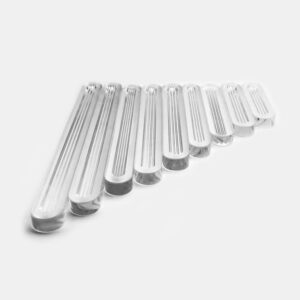How Reflex Gauge Glass Works: Optical Science Explained
Core Operating Principle
- Prismatic light refraction:
- Flat surface vs. grooved section creates 72° light deflection
- Generates 3:1 contrast ratio between liquid/gas phases
- Real-world performance:
- Maintains accuracy (±1.5mm) at temperatures up to 400°C
- Functions without power in explosive environments (ATEX Zone 0 certified)
 5 Key Benefits for Industrial Applications
5 Key Benefits for Industrial Applications
- Unmatched Durability
- Withstands 6.9MPa pressure (ASME B31.1 compliant)
- Resists 98% sulfuric acid and 50% NaOH solutions
- Maintenance Advantages
- Zero calibration requirements
- 5-year mean time between failures (MTBF)
- Cost Efficiency
- 60% lower lifecycle cost than electronic sensors
- No spare parts inventory needed
- Safety Features
- Instant leak detection via visible meniscus
- Prevents $250k/yr in potential overfill incidents (API 2350 compliance)
- Universal Compatibility
- Standard sizes from DN20 to DN150
- Suitable for cryogenic (-196°C) to high-temp (800°C) service
Expert Maintenance Protocol
Daily/Weekly Checks
TaskMethodAcceptance CriteriaVisual inspectionWhite light examinationNo visible cracks/scratchesSeal integrityTorque verification (12-15Nm)Zero weeping
Quarterly Maintenance
- Cleaning Procedure:
- Non-abrasive cloth + isopropyl alcohol (99% purity)
- Avoid ammonia-based cleaners (causes stress corrosion)
- Component Replacement:
- Gasket change interval: 18-24 months
- Full assembly replacement after 10,000 thermal cycles
Industry-Specific Implementation
Oil & Gas Applications
- Crude oil storage:
- UV-stabilized glass formulations
- 25-year design life in offshore platforms
Chemical Processing
- Acid service:
- Borosilicate 3.3 glass option
- PTFE secondary containment
Power Generation
- Boiler drum monitoring:
- 4X safety factor beyond ASME BPVC limits
- Integrated blowdown protection
Future-Proofing Your Installation
- Smart retrofitting:
- Add-on IoT sensors for remote monitoring
- AR-assisted maintenance via QR code integration


 5 Key Benefits for Industrial Applications
5 Key Benefits for Industrial Applications